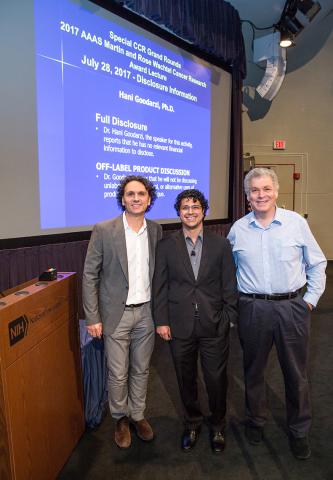Goodarzi Uses Math, RNA Biology to Counter Metastasis

Photo: Chia-Chi Charlie Chang
When a person dies of cancer, it’s usually not the primary tumor that causes death. It’s the metastases, which use the bloodstream as a highway to spread trouble body-wide. Figure out how to arrest these nomadic wanderings and you may go far to limit cancer’s damage.
Dr. Hani Goodarzi, an assistant professor at the University of California, San Francisco, is using his expertise as both a computational and an RNA biologist to investigate ways of thwarting metastases. His work earned him the 2017 Martin and Rose Wachtel Cancer Research Award presented by the American Association for the Advancement of Science. NCI’s Center for Cancer Research co-hosted the award lecture, given recently in Lipsett Amphitheater.
Goodarzi and colleagues are focusing on a mouse model of breast cancer, comparing the gene expression profiles of tumors that have low metastatic activity versus those with high metastatic activity. What makes them different and what drives metastasis?
Disordered gene expression is the root of both cancer and subsequent metastasis, he explained.

Photo: Chia-Chi Charlie Chang
His laboratory has built a platform that measures RNA stability, with the hope of identifying elements that promote the broad destabilization that characterizes tumor development.
Called TEISER, the platform can identify structural elements or “seeds” that could be involved in the spread of cancer; there are about 100 million of them, making the research team reliant on cluster and high-performance computing to winnow drivers from mere passengers.
Goodarzi’s lab has teased out what they call the sRSE, or structural RNA stability element (also called a regulon), but what regulates the regulon?
Over-expression of the TARBP2 gene has been tied to RNA destabilization and appears to be a factor in distinguishing highly metastatic tumors from less active ones. TARBP2 promotes breast cancer metastasis, targeting four transcripts involved in that process.
“These are really amazing times to be an RNA biologist and a computational biologist,” said Goodarzi.
His award was presented by former NIGMS director Dr. Jeremy Berg, who is now editor-in-chief of the Science family of journals; Science is the flagship journal of the AAAS.
Dr. Tom Misteli, director of the Center for Cancer Research, said that the Wachtel Award, now in its 5th year, is getting better every year, with a higher bar set for achieving the honor each year. The award is for early-career investigators, who, Misteli quipped, tend to often produce the most creative work (he acknowledged winces from older scientists in the audience). Misteli encouraged NIH tenure-track investigators to apply early.—Rich McManus
